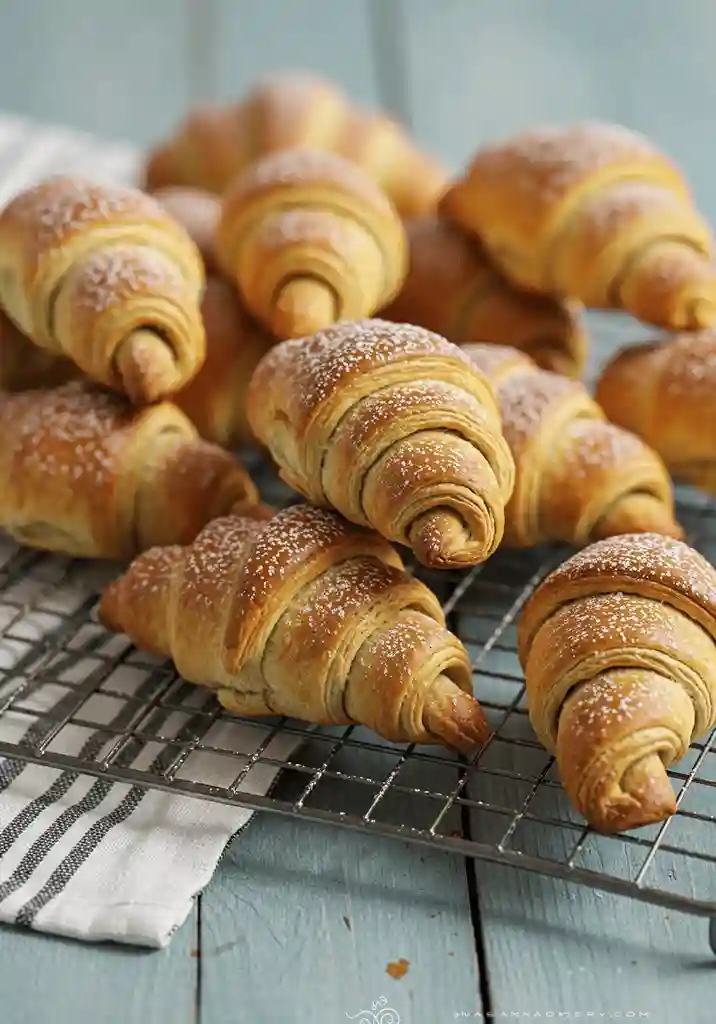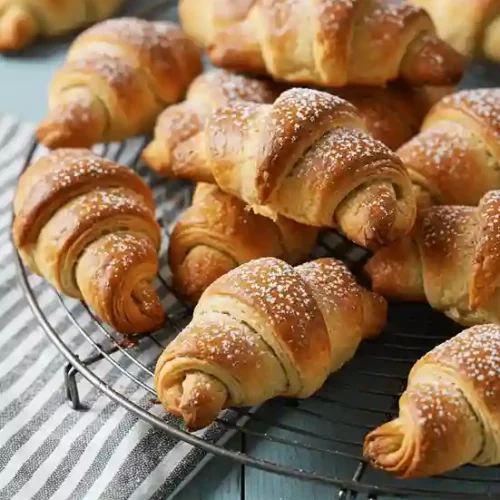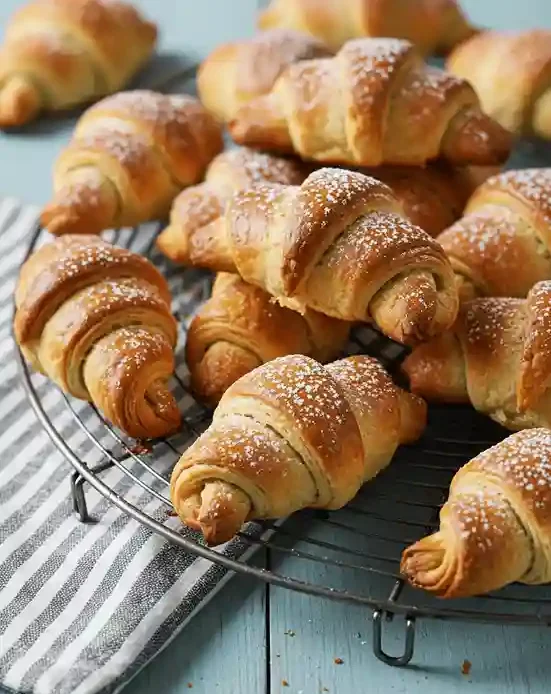If you’re looking for a delightful way to start your day, look no further than the gipfeli recipe. This Swiss pastry is reminiscent of a croissant but brings its unique charm and texture to the breakfast table. With a crispy crust and a slightly denser interior, Gipfeli are perfect for those who appreciate the art of pastry-making. Whether enjoyed plain, filled with sweet or savory fillings, or paired with your morning coffee, the gipfeli recipe can elevate any breakfast or snack time into a special occasion.
Table of Contents
Why Gipfeli?
Gipfeli are not just any pastry; they represent a slice of Swiss culinary tradition. Their appeal lies in their versatility and flavor. Unlike traditional croissants that can sometimes be overly buttery, Gipfeli strike a balance, offering a delightful texture without overwhelming richness. This makes them an excellent choice for various fillings, from fruit jams to creamy cheeses or even savory chicken salad.
Moreover, making the gipfeli recipe at home allows you to control the ingredients, ensuring freshness and quality. If you’ve ever been curious about the world of Swiss pastries, this recipe is an excellent starting point.
Ingredients List
To make your own Gipfeli, you will need the following ingredients for this gipfeli recipe:
- 500g all-purpose flour
- 250ml warm milk
- 50g sugar
- 1 packet active dry yeast (about 7g)
- 1 tsp salt
- 250g unsalted cold butter, cut into small pieces
- 1 egg, beaten

How to Make Gipfeli (Step-by-Step)
Step 1: Activate the Yeast
Start by mixing the active dry yeast with warm milk in a small bowl. You then proceed to stir gently and let the PH level mixture remain idle for about 5 minutes. This step is crucial as it activates the yeast, ensuring your pastry rises beautifully.
Step 2: Prepare the Dough
Then in a bigger bowl, whisk the flour, sugar and salt together. Create a well in the center of the dry ingredients and pour in the frothy yeast and milk mixture. Combine all the ingredients and when it becomes somewhat sticky form a dough.
Step 3: Knead the Dough
Transfer the dough onto a floured surface and knead it for about 10 minutes until it feels smooth and elastic. This step develops the gluten, which gives Gipfeli their structure. Following the gipfeli recipe closely will yield the best results.
Step 4: Let It Rise
Place the kneaded dough into a greased bowl, cover it with a damp cloth, and let it sit in a warm place for about 1 hour. The dough should double in size during this time, which is essential for the gipfeli recipe.
Step 5: Roll Out the Dough
When the dough has fermented roll it out on a floured surface to an approximate size of a sheet of A4 paper.
Step 6: Add the Butter
Distribute small pieces of cold butter evenly over one half of the dough. Fold the other half over the butter, pressing the edges to seal. This technique is vital for achieving the layers in the gipfeli recipe.
Step 7: Roll and Fold
Roll the dough out again into a rectangle, then fold it into thirds like a letter. Repeat this rolling and folding process two more times. This technique creates the flaky layers in your Gipfeli.
Step 8: Chill the Dough
Then cover the dough with plastic foil and put it into a refrigerator for approximately one hour. This way the butter cools again, and that is crucial for the flakiness in the gipfeli dough.
Step 9: Shape the Gipfeli
After chilling, roll the dough out into a rectangle once more and cut it into triangles.
Step 10: Form the Crescents
Starting from the base of each triangle, roll them up towards the tip to create a crescent shape. Place them on a baking sheet lined with parchment paper.
Step 11: Final Rise
Once more cover the shaped Gipfeli with a damp cloth and allow it to rise for another thirty minutes. Meanwhile, preheat your oven to 200°C (400°F).
Step 12: Brush and Bake
Before baking, brush the Gipfeli with the beaten egg to give them a shiny, golden finish. Bake in the preheated oven for 15-20 minutes until they are puffed and beautifully golden. Following the gipfeli recipe will ensure they turn out perfectly.
Why You’ll Love This Recipe
Quick and Easy
With just a few steps, you can create something that looks and tastes gourmet, thanks to the gipfeli recipe.
Versatile
Customize your Gipfeli with sweet or savory fillings to suit your taste.
Impressive
Homemade pastries always impress guests, making them perfect for brunch or special occasions.
Budget-Friendly
Making Gipfeli at home is often more economical than buying them from a bakery.
Comforting
The warm, flaky pastries are incredibly satisfying, perfect for a cozy breakfast.
Key Ingredients and Substitutions
- All-Purpose Flour: This is the backbone of your dough in the gipfeli recipe. While you can experiment with bread flour for a chewier texture, all-purpose flour yields the best results.
- Warm Milk: The warmth is essential for activating yeast. If you prefer, you can use non-dairy milk, but ensure it’s warmed slightly.
- Active Dry Yeast: If you don’t have active dry yeast, you can substitute with instant yeast—there’s no need to activate it first.
- Unsalted Butter: Cold butter is crucial for flakiness. If you’re in a pinch, you can use margarine, but the flavor will differ.
- Egg for Brushing: While an egg wash gives a beautiful finish, you can skip it if you prefer a vegan option or if you want to keep it simple in the gipfeli recipe.
Detailed Explanation of Each Major Step
Activating the Yeast
Activating your yeast is a crucial first step in the gipfeli recipe. Warm milk should feel warm to the touch but not hot—about 110°F is ideal. If the milk is too hot, it can kill the yeast, preventing your dough from rising.
Kneading the Dough
Kneading develops gluten, which is what gives dough its structure. When kneading, you should feel the dough transform from sticky to smooth. If it’s too sticky, add a bit more flour, but be cautious not to add too much to the gipfeli recipe.
Rolling and Folding
The rolling and folding technique is what differentiates a Gipfeli from a regular pastry. This process creates layers that will puff up beautifully in the oven, giving you that flaky texture we all crave from the gipfeli recipe.
Chilling the Dough
Chilling the dough is not just about resting; it’s about maintaining the temperature of the butter. Cold butter creates steam during baking, which results in that sought-after flakiness.
Expert Tips for Success
- Keep Everything Cold: Ensure your ingredients, especially the butter, are cold. This is key to achieving the perfect flakiness in the gipfeli recipe.
- Flour Your Surface: Always flour your surface when rolling out the dough to prevent sticking.
- Don’t Rush the Rising: Allow enough time for the dough to rise. Rushing this step can lead to dense pastries.
- Use a Pastry Brush: A pastry brush is essential for applying the egg wash evenly without deflating the dough.
Variations and Customizations
- Sweet Fillings: Consider filling your Gipfeli with chocolate, fruit preserves, or sweetened cream cheese for a dessert twist.
- Savory Options: Try adding ham and cheese or roasted vegetables for a satisfying brunch option.
- Herbed Dough: Incorporate herbs or spices into the dough for added flavor. Rosemary, thyme, or even a hint of garlic can elevate your Gipfeli’s taste.
Storage and Reheating Instructions
Those remaining Gipfeli should be kept at room temperature in an airtight container for not more than two days. For longer storage, better to put them in a baking sheet in the layer and then store it in a freezer bag. When you’re ready to enjoy them, simply reheat in the oven at 180°C (350°F) for about 10 minutes.
Serving Suggestions
Gipfeli are incredibly versatile and can be paired with various accompaniments. For breakfast, serve them with a refreshing fruit salad or a simple yogurt. They also go wonderfully with a cup of coffee, tea, or fresh juice. If you’re enjoying them as a snack, try spreading a bit of butter or your favorite jam on top.
Frequently Asked Questions (FAQs)
What is a mistake when making croissants?
One common mistake is not allowing the dough to rise adequately. This can lead to dense pastries rather than the light, flaky texture you desire in the gipfeli recipe.
What is the difference between a croissant and a gipfeli?
While both pastries share similar ingredients, Gipfeli typically have a slightly denser texture and a less buttery flavor compared to croissants. They also have a unique rolling technique that distinguishes them.
How many times should you at least read a recipe before you begin?
It’s a good idea to read through the gipfeli recipe at least twice before starting. This allows you to understand the steps involved and gather all necessary ingredients and tools.
Notes
Remember that patience is key when making Gipfeli. The process may take some time, but the result is well worth the effort. Enjoy the experience of creating something delicious from scratch with this gipfeli recipe!
Related Recipes
If you enjoyed this Gipfeli Recipe, you might also like:
In summary, the gipfeli recipe is a delightful addition to your breakfast or snack repertoire. With its crispy exterior and soft, flaky interior, it’s a pastry that brings a taste of Switzerland to your kitchen. Whether you choose to fill them with sweet or savory delights, Gipfeli are sure to impress family and friends. So why not give this gipfeli recipe a try? Experience the joy of baking and enjoy the fruits of your labor with a warm Gipfeli straight from the oven. Happy baking!



